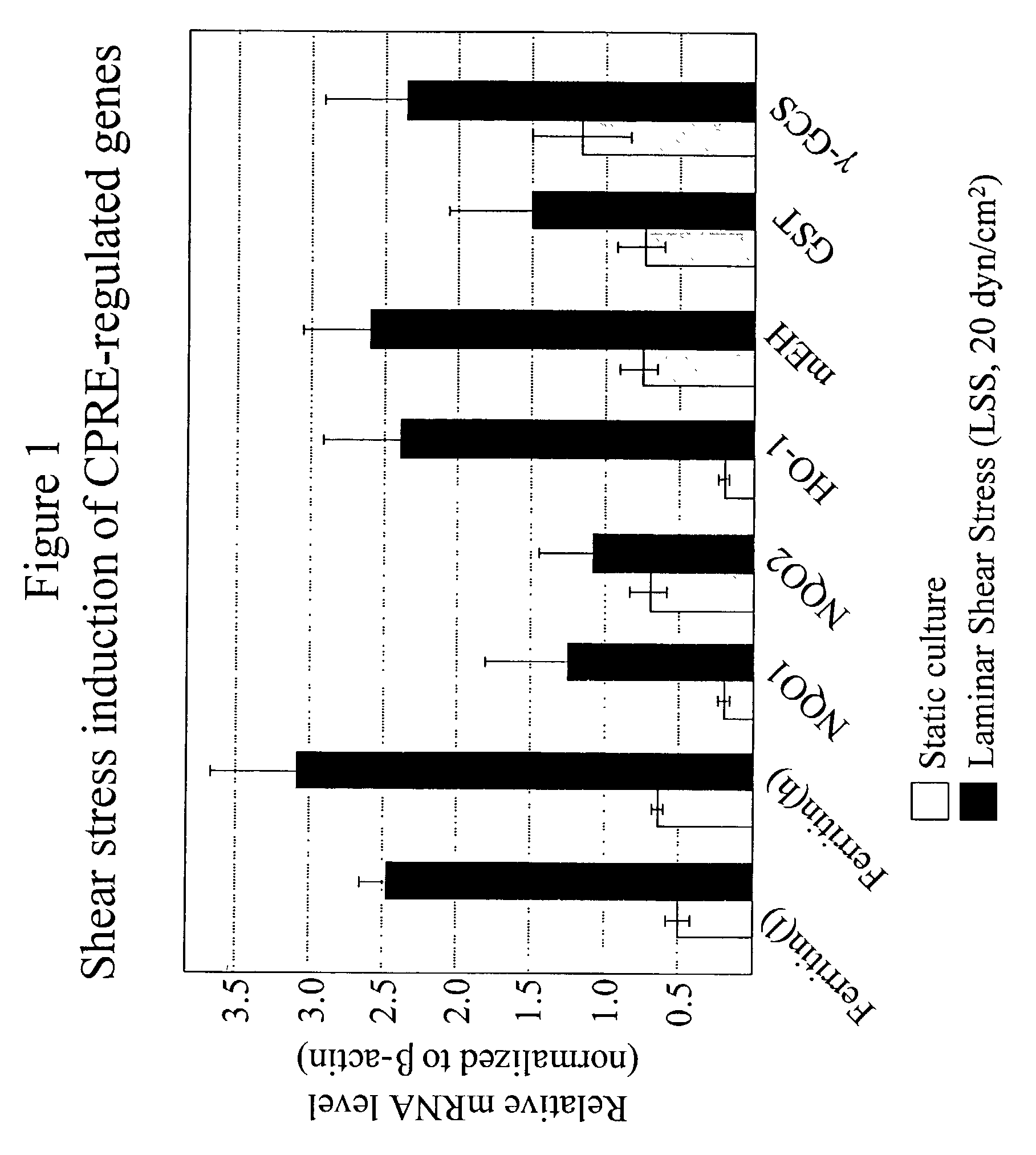Protection against oxidative stress and inflammation by a cytoprotective response element
a cytoprotective response and oxidative stress technology, applied in the field of dna sequence regulation, can solve the problems of unsatisfactory chronic inflammation, unidentified specific nucleotide sequences that comprise the regulatory elements of genes that respond to shear stress stimuli, and unidirectional fluid shear stress in the lesion-protected areas of the vasculature, etc., to inhibit the induction of cpre
- Summary
- Abstract
- Description
- Claims
- Application Information
AI Technical Summary
Benefits of technology
Problems solved by technology
Method used
Image
Examples
example 1
Expression of ARE-containing Genes is Elevated in LSS-exposed EC, Compared to OSS or Static Control Cultures.
[0303]DNA sequencing of subtracted libraries and DNA microarray analysis identified several genes that were upregulated by LSS (vs. static or OSS). Several of these genes were previously reported to be regulated by oxidative stress. Furthermore, some of these genes were reported to be regulated by the antioxidant response element (ARE). To confirm that LSS induces the expression of these genes, mRNA levels were assayed by semi-quantitative RT-PCR. As can be seen from FIG. 1, all of the genes were induced (although to various degrees) by LSS. These include ferritin (heavy and light chains), quinone oxidoreductase-1 & 2 (NQO1 & NQO2), heme oxygenase-1 (HO-1), microsomal epoxide hydrolase (mEH), glutathione-S-transferase (GST), and gamma glutamyl cysteine synthase (γ-GCS). These observations confirm that exposure of EC to LSS for 48 hrs increases expression of these genes compar...
example 2
Shear Stress Activation of the NQO1 Gene is Mediated Via the ARE
[0308]To determine if the effect of LSS on NQO1 gene expression is mediated through transcriptional activation, transient transfection assays were used with a region of the NQO1 promoter. This promoter construct contains the previously characterized ARE region cloned upstream of the chloramphenicol acetyltransferase gene (CAT). The data shown in FIG. 5 demonstrates that exposure of endothelial cells for 48 hours to LSS results in substantial activation of the NQO1 promoter. When a plasmid containing a deletion of the ARE element from NQO1 was used, no activation was observed by LSS. These observations directly demonstrate that LSS activation of the NQO1 gene in endothelial cells occurs at the transcriptional level. More importantly, activation by LSS requires a functional ARE element.
[0309]Human microvascular endothelial cells (HMEC) were grown to 60% confluence on glass plates. The cells were transiently transfected wi...
example 3
Determination of Consensus CPRE Sequence from Alignment of ARE Sequences from the 5′ Regulatory Regions of LSS-activated Genes.
[0310]The observation that the ARE from the NQO1 gene mediates transcriptional activity in response to LSS suggests that the ARE transcriptional element is an important mediator of signals generated in endothelial cells by hemodynamic forces. In addition, since several ARE-containing genes are regulated by LSS (FIG. 1) the sequence similarity of the ARE in the 5′ regions of these genes was examined (FIG. 6).
[0311]Alignment of the 5′ regulatory region from genes that were demonstrated to be inducible by LSS generated a 13 nt sequence core with the sequence 5′-RTGACWNAGCANW-3′ (SEQ ID NO 1). The genes that contain this consensus sequence all have in common the ability to regulate and maintain redox balance within the cell and are responsive to oxidative signals. Based on alignments of these shear stress regulated genes, the consensus sequence was extended beyo...
PUM
| Property | Measurement | Unit |
|---|---|---|
| Length | aaaaa | aaaaa |
| Length | aaaaa | aaaaa |
| Length | aaaaa | aaaaa |
Abstract
Description
Claims
Application Information
 Login to View More
Login to View More - R&D
- Intellectual Property
- Life Sciences
- Materials
- Tech Scout
- Unparalleled Data Quality
- Higher Quality Content
- 60% Fewer Hallucinations
Browse by: Latest US Patents, China's latest patents, Technical Efficacy Thesaurus, Application Domain, Technology Topic, Popular Technical Reports.
© 2025 PatSnap. All rights reserved.Legal|Privacy policy|Modern Slavery Act Transparency Statement|Sitemap|About US| Contact US: help@patsnap.com



